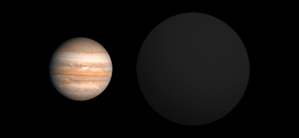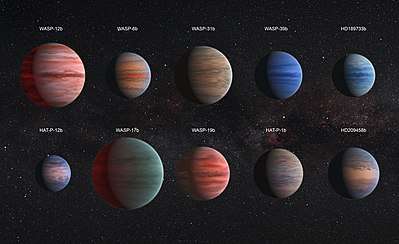WASP-12b
| Exoplanet | List of exoplanets | |
|---|---|---|
 | ||
| Parent star | ||
| Star | WASP-12 | |
| Constellation | Auriga | |
| Right ascension | (α) | 06h 30m 32.7943s[1] |
| Declination | (δ) | +29° 40′ 20.287″[1] |
| Apparent magnitude | (mV) | 11.69 |
| Distance | approx. 1300[1] ly (approx. 390[1] pc) | |
| Spectral type | G0 | |
| Mass | (m) | 1.35 ± 0.14 M☉ |
| Radius | (r) | 1.57 ± 0.07 R☉ |
| Temperature | (T) | 6300+200 −100 K |
| Metallicity | [Fe/H] | 0.30+0.05 −0.15 |
| Orbital elements | ||
| Semi-major axis | (a) | 0.0229 ± 0.0008 AU |
| Eccentricity | (e) | 0.049 ± 0.015 |
| Orbital period | (P) | 1.091423 ± 3e-6 d |
| Inclination | (i) | 83.1+1.4 −1.1° |
| Argument of periastron |
(ω) | -74+13 −10° |
| Time of transit | (Tt) | 2454508.9761 ± 0.0002 JD |
| Physical characteristics | ||
| Mass | (m) | 1.39 ± 0.04[2] MJ |
| Radius | (r) | 1.900+0.057 −0.055,[3] 1.736±0.056[4] RJ |
| Density | (ρ) | 326 kg m−3 |
| Surface gravity | (g) | 1.16 g |
| Temperature | (T) | 2525 K[5] |
| Discovery information | ||
| Discovery date | April 1, 2008[2] | |
| Discoverer(s) | Cameron et al. (SuperWASP) | |
| Discovery method | Transit | |
| Other detection methods | Radial velocity, Orbital light variations | |
| Discovery site | SAAO | |
| Discovery status | Published[5] | |
| Database references | ||
| Extrasolar Planets Encyclopaedia | data | |
| SIMBAD | data | |
| Exoplanet Archive | data | |
| Open Exoplanet Catalogue | data | |
WASP-12b is an extrasolar planet orbiting the star WASP-12, discovered by the SuperWASP planetary transit survey. Its discovery was announced on April 1, 2008.[2] Due to its extremely close orbit to its star, it has one of the lowest densities for exoplanets ('inflated' by the flux of energy from the star). The planet takes only a little over a day to orbit the star, in contrast to 365 days for the Earth to orbit the Sun. Its distance from the star (approximately 2,115,000 miles) is only 1/44 the Earth’s distance from the Sun, with an eccentricity the same as Jupiter's. On 3 December 2013, scientists working with the Hubble Space Telescope (HST) reported detecting water in the atmosphere of the exoplanet.[6][7] In July 2014, NASA announced finding very dry atmospheres on three exoplanets (HD 189733b, HD 209458b, WASP-12b) orbiting sun-like stars.[8]
In September 2017, researchers, working on the HST, announced that WASP-12b absorbs, instead of reflects, at least 94% of the light that shines on its surface. As a result, the exoplanet has been described as "black as asphalt", and as a "pitch black" [9][10] and is a type of planet known as a hot Jupiter.[11]
Characteristics
The planet is so close to WASP-12 that the star's tidal forces are distorting it into an egg shape and pulling away its atmosphere at a rate of about 10−7 MJ (about 189 quadrillion tonnes) per year.[13] The so-called "tidal heating", and the proximity of the planet to its star, combine to bring the surface temperature to more than 2,500 K (2,200 °C).
On May 20, 2010, the Hubble Space Telescope spotted WASP-12b being "consumed" by its star. Scientists had been aware that stars could consume planets; however, this was the first time such an event had been observed so clearly. NASA has estimated that the planet has 10 million years left of its life.[14]
The Hubble Space Telescope observed the planet by using its Cosmic Origins Spectrograph (COS). The observations have confirmed predictions published in Nature in February 2009 by Peking University's Shu-lin Li. The planet's atmosphere has ballooned to be nearly three times the radius of Jupiter, while the planet itself has 40% more mass than Jupiter.
Carbon content
Recent evidence indicates that WASP-12b has an enhanced carbon-to-oxygen ratio, significantly higher than that of the Sun, indicating that it is a carbon-rich gas giant. The C/O ratio compatible with observations is about 1, while the solar value is 0.54. The C/O ratios suggest that carbon-rich planets may have formed in the star system.[15] One of the researchers behind that study commented that "with more carbon than oxygen, you would get rocks of pure carbon, such as diamond or graphite".[16]
The published study states: "Although carbon-rich giant planets like WASP-12b have not been observed, theory predicts myriad compositions for carbon-dominated solid planets. Terrestrial-sized carbon planets, for instance, could be dominated by graphite or diamond interiors, as opposed to the silicate composition of Earth."[15] These remarks have led the media to pick up on the story,[17] some even calling WASP-12b a "diamond planet".[18]
The carbon content of the planet is located within its atmosphere, in the form of carbon monoxide and methane. The study appears in the journal Nature.[19]
.jpg) WASP-12b and its host star, WASP-12 (artist conception).
WASP-12b and its host star, WASP-12 (artist conception). Hot, carbon-rich planet WASP-12b and its host star. (Exoplanet color was unknown at the time of this artist conception).
Hot, carbon-rich planet WASP-12b and its host star. (Exoplanet color was unknown at the time of this artist conception). WASP-12b and its host star, WASP-12 − with IR spectra noting the presence of various chemical molecules.
WASP-12b and its host star, WASP-12 − with IR spectra noting the presence of various chemical molecules. Comparison of "hot Jupiter" exoplanets - from top left to lower right: WASP-12b, WASP-6b, WASP-31b, WASP-39b, HD 189733b, HAT-P-12b, WASP-17b, WASP-19b, HAT-P-1b and HD 209458b.
Comparison of "hot Jupiter" exoplanets - from top left to lower right: WASP-12b, WASP-6b, WASP-31b, WASP-39b, HD 189733b, HAT-P-12b, WASP-17b, WASP-19b, HAT-P-1b and HD 209458b.
Candidate satellite
Russian astronomers studying a curve of change of shine of the planet observed regular splashes of light that imply that WASP-12b has at least one substantial exomoon in orbit around it.[20] This is not expected, as hot Jupiter-type planets are expected to lose large moons within geologically short timescales.[21]
See also
References
- 1 2 3 4 Brown, A. G. A; et al. (2016). "Gaia Data Release 1. Summary of the astrometric, photometric, and survey properties". Astronomy and Astrophysics. 595. A2. arXiv:1609.04172. Bibcode:2016A&A...595A...2G. doi:10.1051/0004-6361/201629512. Gaia Data Release 1 catalog entry
- 1 2 3 "WASP Planets". SuperWASP. Retrieved 2016-01-26.
- ↑ Collins, Karen A; Kielkopf, John F; Stassun, Keivan G (2015). "Transit Timing Variation Measurements of WASP-12b and Qatar-1b: No Evidence for Additional Planets". 1512: arXiv:1512.00464. arXiv:1512.00464 [astro-ph.EP]. Bibcode:2015arXiv151200464C. Cite uses deprecated parameter
|class=(help) - ↑ Chan, Tucker; Ingemyr, Mikael; Winn, Joshua N; Holman, Matthew J; Sanchis-Ojeda, Roberto; Esquerdo, Gil; Everett, Mark (2011). "The Transit Light Curve project. XIV. Confirmation of Anomalous Radii for the Exoplanets TrES-4b, HAT-P-3b, and WASP-12b". The Astronomical Journal. 141 (6): 179. arXiv:1103.3078. Bibcode:2011AJ....141..179C. doi:10.1088/0004-6256/141/6/179.
- 1 2 Hebb; Collier-Cameron, A.; Loeillet, B.; Pollacco, D.; Hébrard, G.; Street, R. A.; Bouchy, F.; Stempels, H. C.; et al. (2009). "WASP-12b: THE HOTTEST TRANSITING EXTRASOLAR PLANET YET DISCOVERED". The Astrophysical Journal. 693 (2): 1920–1928. arXiv:0812.3240. Bibcode:2009ApJ...693.1920H. doi:10.1088/0004-637X/693/2/1920.
- ↑ Staff (3 December 2013). "Hubble Traces Subtle Signals of Water on Hazy Worlds". NASA. Retrieved 4 December 2013.
- ↑ Mandell, Avi M.; Haynes, Korey; Sinukoff, Evan; Madhusudhan, Nikku; Burrows, Adam; Deming, Drake (3 December 2013). "Exoplanet Transit Spectroscopy Using WFC3: WASP-12 b, WASP-17 b, and WASP-19 b". Astrophysical Journal. 779 (2): 128. arXiv:1310.2949. Bibcode:2013ApJ...779..128M. doi:10.1088/0004-637X/779/2/128. Retrieved 4 December 2013.
- ↑ Harrington, J.D.; Villard, Ray (July 24, 2014). "RELEASE 14-197 - Hubble Finds Three Surprisingly Dry Exoplanets". NASA. Retrieved July 25, 2014.
- ↑ Lazzaro, Sage (14 September 2017). "Hubble spots a 'pitch black' hot Jupiter planet that Eats light instead of reflecting it". Daily Mail. Retrieved 14 September 2017.
- ↑ Wall, Mike (18 September 2017). "The hellish world WASP-12b is darker than fresh asphalt in visible light, but glows red-hot in infrared". Scientific American. Retrieved 19 September 2017.
- ↑ https://www.sciencealert.com/hot-jupiter-wasp-104b-one-of-the-darkest-planets-ever
- ↑ "Hubble observes pitch black planet". www.spacetelescope.org. Retrieved 15 September 2017.
- ↑ Li, Shu-lin; Miller, N.; Lin, Douglas N. C. & Fortney, Jonathan J. (2010). "WASP-12b as a prolate, inflated and disrupting planet from tidal dissipation". Nature. 463 (7284): 1054–1056. arXiv:1002.4608. Bibcode:2010Natur.463.1054L. doi:10.1038/nature08715. PMID 20182506.
- ↑ Hubble Finds a Star Eating a Planet nasa.gov. 2010-05-20. Retrieved on 2010-12-10.
- 1 2 Madhusudhan, N.; Harrington, J.; Stevenson, K. B.; Nymeyer, S.; Campo, C. J.; Wheatley, P. J.; Deming, D.; Blecic, J.; Hardy, R. A.; Lust, N. B.; Anderson, D. R.; Collier-Cameron, A.; Britt, C. B. T.; Bowman, W. C.; Hebb, L.; Hellier, C.; Maxted, P. F. L.; Pollacco, D.; West, R. G. (2010). "A high C/O ratio and weak thermal inversion in the atmosphere of exoplanet WASP-12b". Nature. 469 (7328): 64–67. arXiv:1012.1603. Bibcode:2011Natur.469...64M. doi:10.1038/nature09602. PMID 21150901.
- ↑ "Carbon-Rich Planet: A Girl's Best Friend?". U.S. News & World Report. 10 December 2010.
- ↑ Lorianna De Giorgio (10 December 2010). "Carbon-rich planet could house diamonds". Toronto Star.
- ↑ "Diamond planet found by Keele University astronomers". BBC News Online. 9 December 2010.
- ↑ Intagliata, Christopher (December 9, 2010). "Exoplanet Strikes Carbon Pay Dirt". Scientific American.
- ↑ Российские астрономы впервые открыли луну возле экзопланеты (in Russian) - "Studying of a curve of change of shine of WASP-12b has brought to the Russian astronomers unusual result: regular splashes were found out.<...> Though stains on a star surface also can cause similar changes of shine, observable splashes are very similar on duration, a profile and amplitude that testifies for benefit of exomoon existence."
- ↑ Barnes, Jason W.; O'Brien, D. P. (2002). "Stability of Satellites around Close-in Extrasolar Giant Planets". The Astrophysical Journal. 575: 1087. arXiv:astro-ph/0205035. Bibcode:2002ApJ...575.1087B. doi:10.1086/341477.
External links
![]()
